Frequently Asked Questions
How do I get a copy of the National Flood Insurance Rate Map (FIRM) for my area?
Call the Maumee River Basin Commission at (260-449-7226) or your local Planning and Zoning Department. You may also call the Federal Emergency Management Agency (FEMA) Map Service Center at 1-800-358-9616. Click here for FIRMs on the web.
What is a "100-year flood"?
The term "100-year flood" is misleading. It is not the flood that will occur once every 100 years. Rather, it is the flood elevation that has a 1- percent chance of being equaled or exceeded each year. Thus, the 100-year flood could occur more than once in a relatively short period of time. The 100-year flood, which is the standard used by most Federal and state agencies, is used by the NFIP as the standard for floodplain management and to determine the need for flood insurance. A structure located within a special flood hazard area shown on an NFIP map has a 26 percent chance of suffering flood damage during the term of a 30 year mortgage.
My bank has notified me and said my home and / or property is in the floodplain and I’m being required to buy Flood Insurance. I disagree with this determination. What can I do?
If a lending institution is federally regulated or making federally-backed loans, it must review the NFIP maps to determine if the building is located in a Special Flood Hazard Area. The SFHA is the area that is expected to be inundated by a 1% annual chance flood. If the bank makes such a determination, it must require the borrower to purchase flood insurance. Please note, these determinations are purely in/out and do not involve the vertical elevation of the structure. If you disagree with the lending institution's determination, you may request that FEMA review the lender's determination. FEMA will then review the information that the lending institution used, and issue a letter that states whether we agree with the determination. Your request must be postmarked no later than 45 days after the lending institution notifies you of the flood insurance requirement and the submittal must be complete. The request must include all of the information and fees listed in the Letter of Determination Review (LODR) information sheet. If your request is postmarked after the 45-day limit has expired, or if we do not receive all of the information within the 45-day limit, we will not be able to review the determination and the flood insurance requirement stands. FEMA's responses to these requests are called LODRs, and offer two basic dispositions: (1) the lender's determination stands or (2)it is overturned. FEMA's determination is based on the technical data submitted. If the lender's evidence is inconclusive or the request is incomplete FEMA can disagree with the lender's determination. FEMA's response does not amend or revise the NFIP map for your community. It only states that FEMA agrees or disagrees with your lender's determination. Occasionally a lending institution may require insurance if it determines that a part of your lot is in the SFHA. The NFIP does not insure land. However, even if you submit evidence that your building is out of the floodplain, the bank may still decide to require insurance on your building.
The current effective Flood Insurance Rate Map (FIRM) shows that my property is mapped in the Special Flood Hazard Area (floodplain), but I believe my house is on higher ground and should not be mapped in the floodplain. What are FEMA’s requirements to remove land or a building from the 1% Annual Chance Flood Hazard Area?
To be removed the floodplain shown on the Flood Insurance Rate Map, a structure must be on land that is not subject to flooding by the 1% annual chance flood. Remember, more severe floods can and do happen, so even if your home is found to be on high ground, it may still be damaged by an extreme flood event. If your lot or building site is on natural ground that is higher than the Base Flood Elevation shown on the FIRM, then you may request a Letter of Map Amendment (LOMA). To support your request, you will have to retain the services of a Professional Land Surveyor, licensed in your state, to determine the elevation of the ground next to your building and complete an Elevation Certificate. If the ground at the lowest point next to your building is higher than the Base Flood Elevation, then FEMA may issue a LOMA. With a LOMA, your lender may choose to not require flood insurance. If your home was built on fill that was placed after the FIRM was prepared, you may request a Letter of Map Revision Based on Fill (LOMR-F). As with a LOMA, you will need to submit an Elevation Certificate completed by a licensed Professional Land Surveyor. If the filled ground is higher than the Base Flood Elevation, and if you do not have a basement, then FEMA may issue a LOMR-F, and your lender may choose to not require flood insurance.



